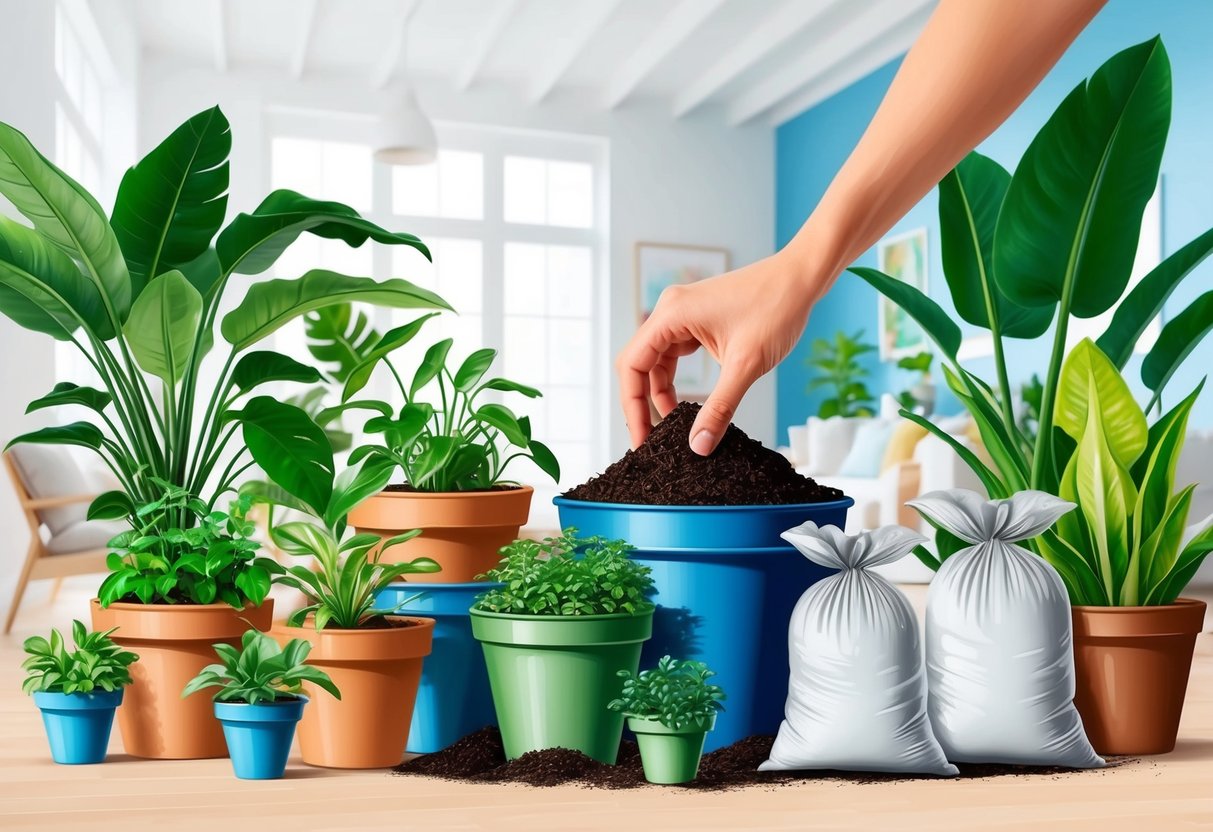
Choosing the Right Pot and Soil

The right combination of pot and well-draining soil makes a significant difference in the growth and health of fast-growing houseplants.
Proper plant care starts with these foundational choices, impacting how efficiently water and nutrients reach the roots and how quickly plants rebound after repotting.
Well-Draining Soil Essentials
For healthy indoor plants, selecting the appropriate soil is critical.
Well-draining soil helps prevent root rot, one of the most common issues in houseplant care, especially for species that grow quickly like pothos, spider plants, and philodendron.
A good fast-growing houseplant soil mix often contains a blend of peat moss or coco coir, perlite, and a bit of compost or worm castings.
This provides essential nutrients while keeping the substrate airy and loose.
Key ingredients for well-draining soil:
- Coconut coir or peat moss (for moisture retention)
- Perlite or pumice (promotes aeration)
- Compost or worm castings (supplies nutrients)
Avoid heavy garden soils, which compact over time and restrict root expansion.
Regularly checking for soil compaction and replacing the mix during repotting will support consistent, vigorous growth.
Pot Selection for Fast Growth
Choosing the correct pot goes hand in hand with proper soil.
Pots should have drainage holes to allow excess water to escape, reducing the chance of soggy soil.
Terracotta and ceramic pots are porous, helping soil dry faster, which benefits plants that dislike “wet feet.”
Consider these factors when picking a pot:
- Size: Select a pot only 1-2 inches larger in diameter than the plant’s current root system to avoid waterlogged soil.
- Material: Terracotta breathes, while plastic retains moisture longer.
- Shape: Wide, shallow pots suit plants prone to sprawling roots, while deeper pots accommodate robust root development.
Repotting fast-growing indoor plants every year or when roots outgrow the pot ensures the plant has enough space for both nutrient uptake and continued rapid growth.
Clean pots thoroughly before reuse to prevent disease and pests.
Top 10 Fast-Growing Houseplants
Indoor gardeners looking for lush, thriving greenery can achieve quick visual impact with the right houseplants.
Some species excel at rapid growth, adapting to a variety of indoor conditions and requiring minimal maintenance.
Spider Plant (Chlorophytum comosum)
The spider plant is recognized for its resilience and adaptability, making it a classic choice for fast indoor growth.
Its arching, narrow green leaves are often striped with white, creating a striking appearance.
When placed in indirect light, it sends out long stems with baby spiderettes, which can be propagated easily.
Spider plants are well-suited for hanging baskets or shelves.
They prefer moderate watering and well-draining soil and are tolerant to neglect and fluctuations in temperature.
Spider plants are also noted for their ability to clean indoor air and thrive even in low light, making them suitable for homes and offices.
Pothos (Epipremnum aureum)
Pothos, often called devil’s ivy, is favored for its rapid growth and vine-like stems that can be trained to climb or trail.
The heart-shaped leaves come in green, gold, or variegated patterns, adding texture and color to any interior.
Fast-growing pothos can thrive in low to bright, indirect light.
This species requires infrequent watering, making it ideal for beginners or busy households.
As a low-maintenance option, pothos tolerates pruning, which encourages even fuller growth.
Golden pothos, in particular, is highlighted among top performers for fast growth.
Snake Plant (Sansevieria)
The snake plant, also known as mother-in-law’s tongue, is highly valued for its upright, sword-like leaves. This houseplant grows quickly in warm conditions and tolerates a range of lighting situations, from low light corners to bright sunny windows.
Its striking vertical form adds a modern touch. Snake plants are among the easiest to care for, requiring little water and resisting most pests.
They’re also recognized for filtering indoor toxins and improving air quality. With minimal care, new shoots emerge frequently during the growing season.
Aloe Vera
Aloe vera is sought after for both its medicinal uses and its ability to flourish rapidly indoors. This succulent features fleshy, pointed leaves that can be harvested for soothing gels.
It does best with plenty of bright, indirect sunlight and well-draining, sandy soil. Aloe vera thrives on neglect, needing only occasional watering.
The plant produces small offsets or “pups” at its base, which can be separated and grown into new plants. Its aesthetic appeal is complemented by its practical use in treating minor burns and skin irritations.
Philodendron
Philodendrons are tropical plants with attractive foliage ranging from heart-shaped to deeply lobed leaves. These vigorous growers adapt well to indoor environments and can climb a moss pole or trail from a hanging basket.
There are vining and non-vining types, useful for different layout needs. They thrive in moderate to bright, indirect light and require regular but not excessive watering.
Philodendrons respond quickly to pruning, which can encourage fuller, bushier growth. Common species like Philodendron hederaceum are popular for their rapid development and lush greenery.
Fiddle Leaf Fig
Fiddle leaf fig stands out for its big, violin-shaped leaves and sculptural form. Under the right conditions—bright, filtered light and consistent moisture—this plant grows noticeably fast, forming bold vertical columns.
Fiddle leaf figs prefer a stable environment with humidity and well-draining soil. Regular dusting and pruning can help maintain its shape and encourage strong, healthy growth.
It is sensitive to overwatering but can recover quickly from neglect, especially during the active growing season.
Monstera deliciosa
Monstera deliciosa is known for its large, perforated leaves and fast rate of growth. When supported with a moss pole or trellis, it produces dramatic, fenestrated foliage that is emblematic of the tropical indoor plant trend.
It adapts well to low or filtered light but thrives fastest with consistent moderate sunlight. Regular watering and occasional feeding enhance its vigorous growth.
Monstera’s aerial roots help it anchor and climb, contributing to its impressive size. Its adaptability and bold leaf structure make Monstera a favorite for creating a lush indoor jungle.